Imagine a lush, verdant oasis within the confines of your home—a sanctuary brimming with life, color, and tranquility. Indoor plants can transform your living space, purifying the air and boosting your mood. But cultivating this personal paradise comes with challenges. One crucial, yet often overlooked, aspect of nurturing your indoor jungle is mastering the art of proper drainage.
In this comprehensive guide, we’ll dive into the fascinating world of drainage in indoor plant watering. Unravel the mysteries behind root rot and overwatering, and discover the secrets to keeping your leafy companions vibrant and thriving.
So, plant enthusiasts, let’s embark on this enlightening journey and unlock the hidden potential of well-drained, flourishing greenery in your very own indoor oasis.
Understanding Root Rot and Overwatering
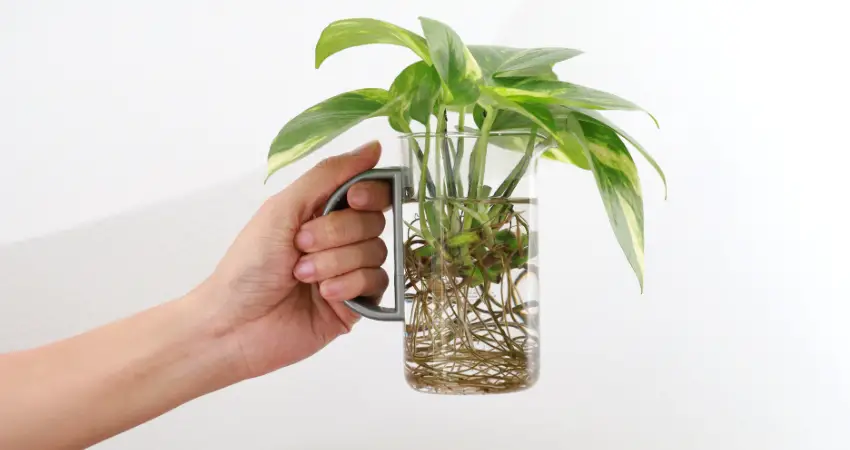
Root Rot
Root rot is a common issue affecting indoor plants. It occurs when the roots of a plant become infected by fungi or other pathogens due to excessive moisture in the soil. Causes of root rot include overwatering, poorly draining soil, and inadequate aeration. Symptoms of root rot include yellowing or wilting leaves, a foul smell emanating from the soil, and mushy, discolored roots.
Overwatering
Overwatering is another problem that can plague indoor plants. It happens when plants receive too much water, leading to waterlogged soil and root suffocation. The main causes of overwatering are improper watering techniques, overly-retentive soil, and inadequate drainage. Symptoms of overwatering are similar to those of root rot, making it important to examine the roots to differentiate between the two.
While root rot and overwatering are distinct issues, they are interconnected. Overwatering can lead to root rot by creating an environment conducive to fungal growth. In turn, root rot can exacerbate overwatering by damaging a plant’s ability to take up water properly.
Indoor Plant Watering Basics
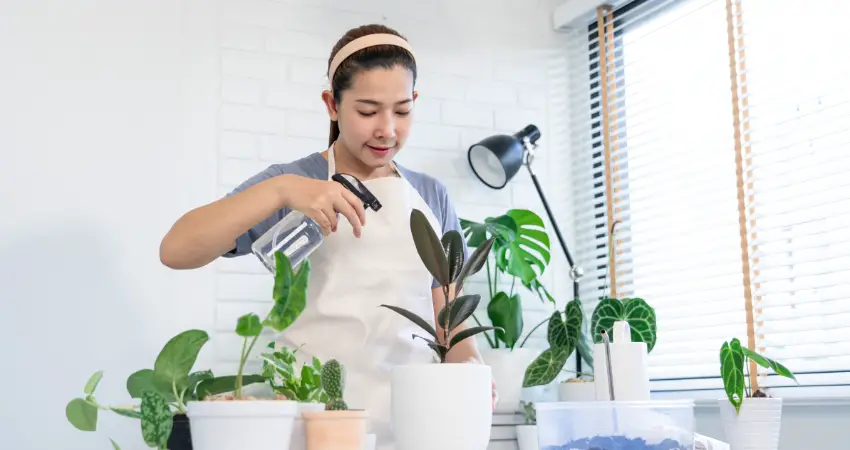
Water Requirements for Different Plant Species
Each plant species has its unique water requirements, which are influenced by factors such as:
- Plant size
- Growth stage
- Environmental factors (light, temperature, humidity)
It’s essential to research the specific watering needs of your indoor plants to ensure they receive the appropriate amount of water.
Watering Techniques
There are various watering techniques you can employ to cater to your indoor plants’ needs:
- Top-watering: This involves pouring water directly onto the soil surface, allowing it to percolate through the soil and exit through drainage holes. It’s essential to water thoroughly, ensuring the entire root ball is moistened, then let the excess water drain away.
- Bottom-watering: This method involves placing a plant’s pot in a tray or saucer filled with water, letting the soil soak up water from the bottom. After a specified period, remove the plant from the water source and let it drain.
- Self-watering systems: These systems use wicks, reservoirs, or other mechanisms to provide a consistent water supply to plants, reducing the risk of overwatering or underwatering.
Proper watering will result in healthy, thriving plants with deep green leaves, robust growth, and strong root systems.
The Role of Drainage in Indoor Plant Watering
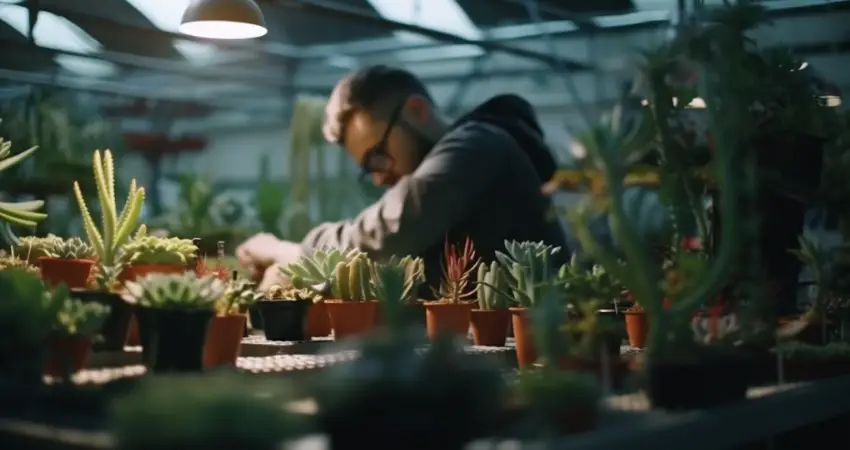
Soil and Drainage
The type of soil you use plays a significant role in your indoor plant’s drainage. There are two main types of soil:
- Well-draining soil: This soil allows water to pass through quickly, preventing waterlogging. It often contains a mix of organic and inorganic materials, such as peat moss, perlite, and vermiculite.
- Water-retaining soil: This soil holds onto water for longer periods, which can be beneficial for some plants but detrimental for others. It often contains higher proportions of clay or organic matter.
When selecting soil for your indoor plants, consider their specific water needs and choose a mix that promotes healthy drainage.
Drainage Components and Systems
Proper drainage requires the use of drainage components and systems, such as:
- Drainage holes: These are openings at the bottom of a pot that allow excess water to escape. Drainage holes are essential for preventing waterlogging and promoting aeration.
- Drainage layers: These are layers of materials placed at the bottom of a pot to improve drainage and aeration. Common drainage layer materials include:
a. Gravel
b. Clay pebbles
c. Perlite - Saucers and trays: These are placed under pots to catch excess water as it drains out. Saucers and trays help prevent damage to surfaces and make it easier to monitor water drainage.
Drainage-Enhancing Techniques
There are several techniques you can use to improve drainage in your indoor plants:
- Elevating pots: Using pot feet, bricks, or other means to lift pots off the ground can improve air circulation and drainage.
- Double potting: This involves placing a smaller pot with drainage holes inside a larger, decorative pot without drainage holes. The gap between the pots helps prevent waterlogging by allowing excess water to escape.
- Wick systems: These systems use a wick to draw excess water away from the soil and into a separate reservoir, promoting optimal soil moisture levels.
Preventing Root Rot and Overwatering Through Proper Drainage
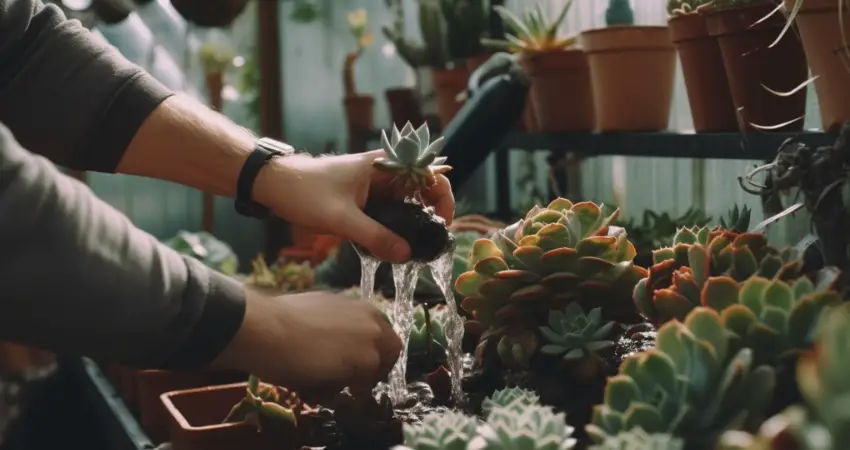
Choosing the Right Pot
Selecting an appropriate pot is crucial for proper drainage. Consider the following factors when choosing a pot for your indoor plant:
- Material: Pots can be made from various materials, such as plastic, ceramic, and terracotta, each with its drainage characteristics. For instance, terracotta pots are porous, allowing for better air circulation and moisture evaporation.
- Size: A pot should be appropriately sized for the plant it houses, providing enough room for root growth without being too large, which can lead to water retention.
- Drainage hole considerations: Ensure the pot has sufficient drainage holes to allow excess water to escape.
Selecting Appropriate Soil Mixtures
The right soil mixture will help promote proper drainage and prevent root rot and overwatering. When choosing a soil mix, consider including the following materials:
- Organic materials: a. Sphagnum peat moss: Provides aeration and retains moisture. b. Coconut coir: A sustainable alternative to peat moss that offers similar benefits.
- Inorganic materials: a. Perlite: Increases drainage and aeration. b. Vermiculite: Retains moisture while promoting drainage.
Monitoring Water and Moisture Levels
Regularly monitoring your indoor plants’ water and moisture levels can help prevent root rot and overwatering. You can use the following methods to gauge soil moisture:
- Moisture meters: These devices measure the moisture content of the soil and provide an accurate reading of when to water your plants.
- Physical inspection methods: a. Finger test: Insert your finger into the soil up to the second knuckle. If it feels dry, it’s time to water your plant. b. Weight test: Lift the pot to gauge its weight. A lighter pot typically indicates that the soil is dry and requires watering.
Identifying and Treating Root Rot and Overwatering
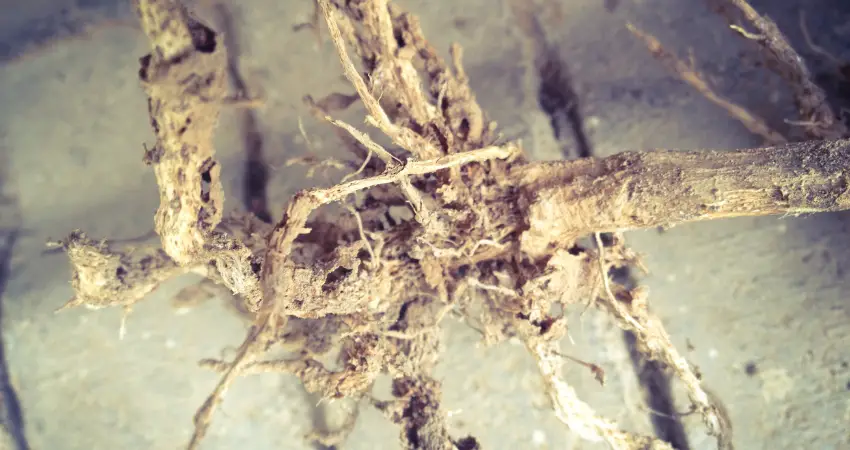
Diagnosis
Diagnosing root rot or overwatering requires careful observation of your plants’ symptoms and, in some cases, a root examination. Look for visual signs, such as yellowing or wilting leaves, and examine the roots for discoloration or mushiness.
Treatment Options
If you’ve identified root rot or overwatering, consider the following treatment options:
- Adjusting watering habits: Ensure you are watering your plants according to their specific needs and avoid overwatering. Allow the soil to dry out slightly between waterings to promote healthy root growth.
- Repotting and changing soil: If root rot or overwatering has caused significant damage, it may be necessary to repot the plant and replace the soil. Choose a well-draining soil mixture and a pot with adequate drainage holes.
- Trimming damaged roots: In the case of root rot, you may need to trim away the affected roots using sterilized pruning shears. This can help prevent the spread of the infection and promote healthy root growth.
- Fungicides and biological controls: For severe root rot cases, consider using fungicides or biological control agents to treat the infection. Be sure to follow the manufacturer’s instructions and research the compatibility of these treatments with your specific plant species.
Bottom Line
Proper drainage plays a vital role in maintaining healthy indoor plants and preventing issues like root rot and overwatering. By understanding the importance of drainage, selecting appropriate pots, soil mixtures, and drainage systems, and monitoring your plants’ water and moisture levels, you can enjoy thriving indoor plants that enhance your living spaces. Remember, attentive care and monitoring are key to ensuring the well-being of your indoor plants.
